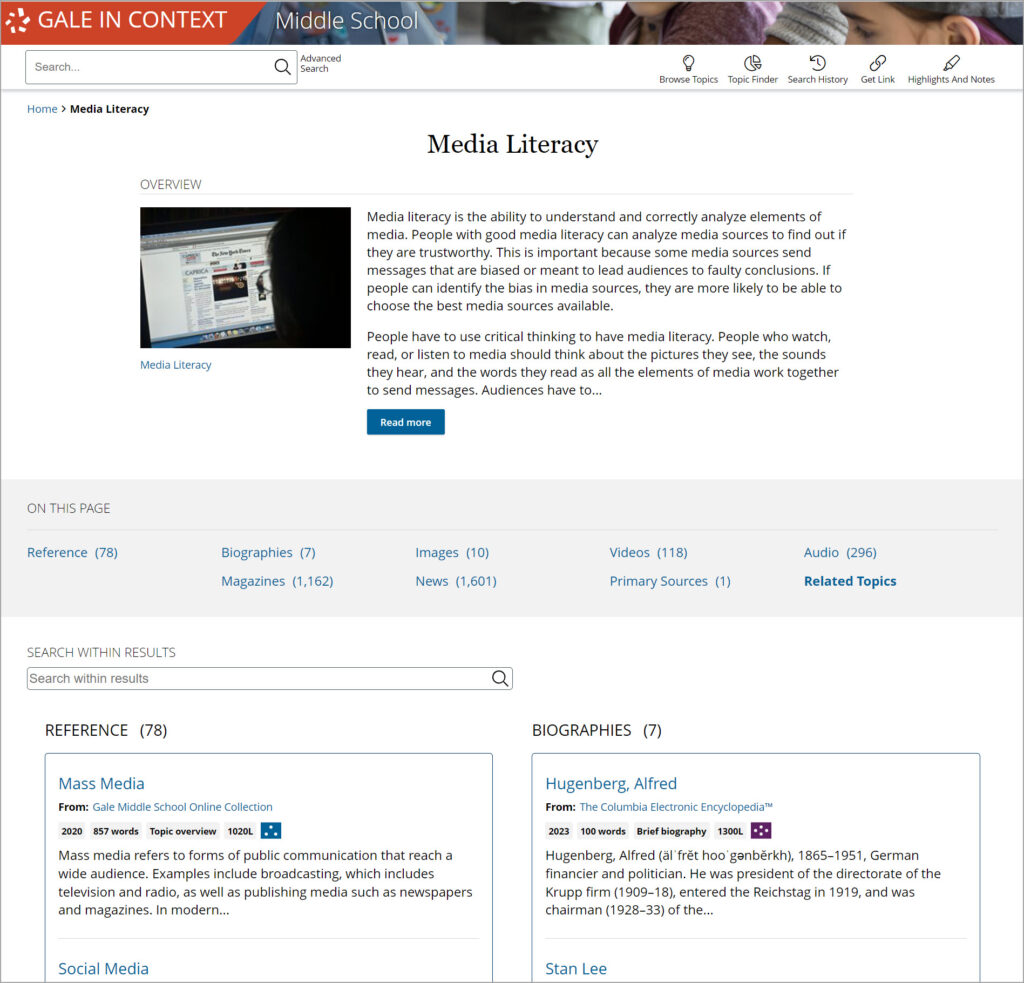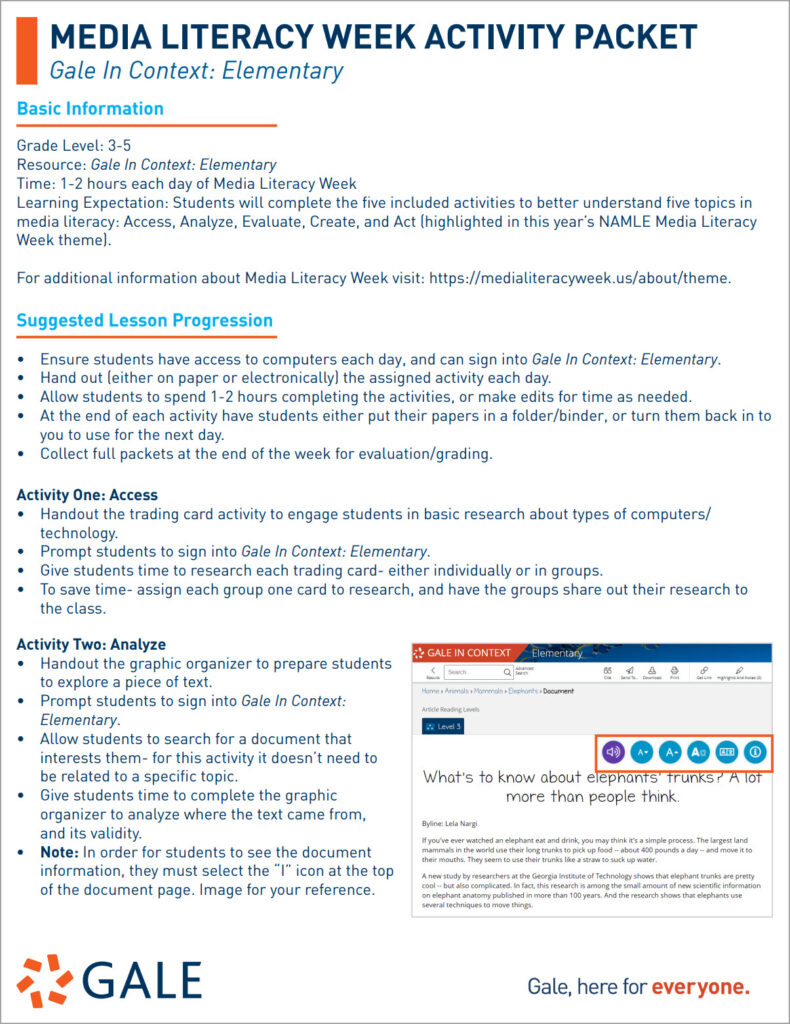| By Gale Staff |
Media literacy is essential for young people to become informed and responsible digital citizens in an age where we are constantly bombarded with information. It empowers them to critically evaluate the messages they receive and make informed decisions about how to consume media. By integrating media literacy into classrooms, educators can foster a culture of critical thinking and help students develop the skills they need to navigate the online world safely and confidently.
New Training Materials for Media Literacy Week 2023
Gale’s new training materials to support educators during Media Literacy Week 2023 can help you teach your students the skills they need to be critical media consumers.
These ready-to-use activity packets cover elementary, middle, and high school grades, and are designed to engage your students throughout the week. With daily lessons adaptable to different timeframes, you can fit media literacy instruction into your busy schedule.
Gale’s comprehensive approach ensures that educators are equipped to address media literacy for all age groups:
- Elementary Educators: Engage younger students with age-appropriate resources, activity ideas, and articles tailored for their level.
- Middle School Educators: Introduce middle-grade learners to diverse examples of media literacy concepts, keeping them engaged in the lessons without being overwhelmed.
- High School Educators: Delve deeper as students approach adulthood, focusing on nuanced issues related to media consumption and creation.
- Success in Every Classroom: Provide a wide array of practical strategies and teaching best practices that educators across all grade levels and subjects can use to foster a culture of critical thinking and media literacy among their students.
These resources bring the exciting world of media literacy to life, offering tailored approaches and creative program ideas designed to captivate children’s attention, engaging them in the vibrant sphere of worldwide cultural celebrations. Let’s break them down.
Build Strong Foundations with Gale In Context: Elementary
Gale In Context: Elementary is a dynamic digital resource that helps young learners explore the world and develop media literacy skills.
Elementary blends grade-appropriate reference content with vivid multimedia properties in a student-friendly interface.
Here are some highlights, perfect for igniting curiosity about the world:
Gale In Context: Elementary features that enhance learning experience and bolster media literacy among young learners, such as:
- Illustrated Content: Visual learning is pivotal in the formative years, and Gale In Context: Elementary provides numerous images and videos to appeal to these young visual learners. Vibrant content helps students connect textual information and visual representations, an essential part of media literacy.
- Interactive Activities: “Question of the Week” challenges, scavenger hunts, and more. Prompt students to interact with media, search for information, distinguish between reliable and unreliable sources, and share findings — all critical components of media literacy.
- Topic Pages: Children are introduced to various facets of media through the easily digestible topic pages. Understanding the role of media in sectors like sports, arts, science, etc., stimulates critical thinking in analyzing media messages.
- Updated Articles: Regularly updated articles mean students learn to adapt to the constant influx of information, developing essential skills to navigate the evolving media landscape.
Prep Your Middle Schoolers for High School
Gale In Context: Middle School is a reliable resource platform designed to empower the next generation of media-literate students. It is specifically designed for grades 6 to 8 and aligns well with teaching standards in English language arts, social studies, and science.
Gale In Context: Middle School supports media literacy in the following ways:
- Wide-Ranging Topics: With content on divergent topics from government to geography, and history to science, students explore vast areas of knowledge and understand how media coverage interacts with these subjects, aiding in critical evaluation of information.
- Diverse Learning Styles: This platform helps students decipher different media formats, a fundamental aspect of media literacy, by accommodating a variety of learning styles through informational text, books, images, audio, video, newspapers, and primary sources.
- Authoritative Information: Sourced from revered entities like National Geographic, NPR, NASA, and AP Video news, it aids students in distinguishing trustworthy sources, and building their capacity to assess the value and accuracy of information.
- Citation Tools: Gale In Context: Middle School equips students with skills to attribute content correctly, promoting appropriate use and dissemination of information, with integrated citation tools supporting various styles—MLA, APA, and Chicago.
Gale In Context: Middle School helps students develop critical thinking skills around media and understand the influence of media on society.

Utilize the Unique Features of Gale In Context: High School for Media Literacy Skills
Intended to meet the dynamic demands of high school curricula, Gale In Context: High School facilitates a formidable platform to amplify high school students’ media literacy, equipping them to be informed citizens and future-ready.
Here are some unique features of High School that aid in the development of media literacy:
- Varied Content Types: From academic journals, magazines, newspapers, and podcasts to videos—the platform makes different media types accessible, providing hands-on experience in understanding, evaluating, and creating varied content.
- Resource Portal: Provides an extensive database of primary sources, critical for students learning advanced research techniques and understanding firsthand information dissemination.
- User-Friendly Interface: With filters and tools to narrow down research topics, it nurtures the ability to sieve relevant information amidst digital information abundance.
- Customizable Content Engagement: Features like highlighting, note-taking, and advanced bookmarking allow students to engage deeper with content, a critical aspect of media literacy.
- Robust Citation Tools: Supports various citation styles—MLA, APA, and Chicago—important for understanding the ethical use of information and preventing plagiarism.
Use Gale Day-to-Day to Change Your Classroom and Your World
The Gale In Context series helps educators teach essential media literacy skills to young students. It offers comprehensive lessons on:
- Understanding Media Messages: Start discussions about simple print and digital advertisements, helping students understand how visuals and words are used together to convey a message.
- Evaluating Credibility: Teach students to verify information from multiple sources, fostering a sense of skepticism and knowledge of fact-checking.
- Recognizing Media Influence: Introduce the concept of media influence on our thoughts and opinions.
- Media & Society: Discuss how media shapes our societal norms and expectations.
Educators can use these targeted media literacy lessons and Gale In Context resources to mold informed, conscious, and responsible consumers of media from an early age. Learn more about how the Gale In Context series can benefit your classroom by visiting our website.


